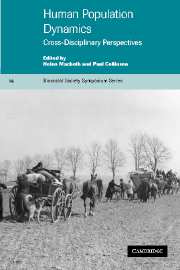Book contents
- Frontmatter
- Contents
- List of contributors
- Foreword by G.A. Harrison
- Preface
- 1 Introduction: the framework of studying human population dynamics
- 2 Demographic perspectives on human population dynamics
- 3 The growing concentration of world population from 1950 to 2050
- 4 Population, community and society in peasant societies
- 5 From genetic variation to population dynamics: insights into the biological understanding of humans
- 6 Social institutions and demographic regimes in non-industrial societies: a comparative approach
- 7 The dynamics of child survival
- 8 Genetic structure of south Indian caste populations: a confluence of biology and culture
- 9 Fertility, mortality and migration transitions in association with socioeconomic modernisation among highland minority populations in Southeast Asia
- 10 Ecology, homeostasis and survival in human population dynamics
- Glossary
- Index
- References
6 - Social institutions and demographic regimes in non-industrial societies: a comparative approach
Published online by Cambridge University Press: 11 August 2009
- Frontmatter
- Contents
- List of contributors
- Foreword by G.A. Harrison
- Preface
- 1 Introduction: the framework of studying human population dynamics
- 2 Demographic perspectives on human population dynamics
- 3 The growing concentration of world population from 1950 to 2050
- 4 Population, community and society in peasant societies
- 5 From genetic variation to population dynamics: insights into the biological understanding of humans
- 6 Social institutions and demographic regimes in non-industrial societies: a comparative approach
- 7 The dynamics of child survival
- 8 Genetic structure of south Indian caste populations: a confluence of biology and culture
- 9 Fertility, mortality and migration transitions in association with socioeconomic modernisation among highland minority populations in Southeast Asia
- 10 Ecology, homeostasis and survival in human population dynamics
- Glossary
- Index
- References
Summary
In most non-industrial societies the key social institution determining the character of the demographic regime is the family or kinship system. In studying such an influence on the demographic characteristics of agrarian societies of the past or the present, historians of the family, social anthropologists and sociologists have frequently been badly served by the quality of the demographic data available. The collection of vital records is frequently a development that emerges once a society is well advanced on the path of economic development. Historical demography has therefore attracted the attention of students of demographic systems in non-industrial societies working in a variety of disciplines, since it has forged a methodology that has generated high quality data using the records of ecclesiastical parishes.
As a sub-discipline of the social sciences, historical demography has generated findings disproportionately from past European societies, since its methodology has been heavily dependent upon exploitation of a particular class of records relating to the registration of baptisms, marriages and burials by the parochial clergy of the Christian Church – a practice that was widely pursued from the sixteenth century (Mols 1954). Historical demography has also been able to assemble evidence from those parts of the world which were colonised by Europeans who carried with them registration practices that had long characterised their homelands. Investigations of past demographic conditions in areas that were not so completely colonised by Europeans are more restricted in scope, dependent on use of different types of evidence or on the registrations of events made by missionaries for those sections of societies that were subsequently Christianised.
- Type
- Chapter
- Information
- Human Population DynamicsCross-Disciplinary Perspectives, pp. 103 - 123Publisher: Cambridge University PressPrint publication year: 2002
References
- 1
- Cited by



